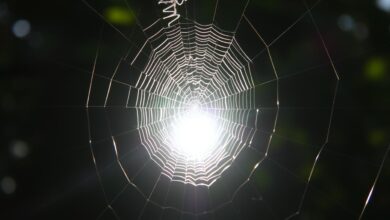World’s Largest Spider: Meet the Goliath Birdeater
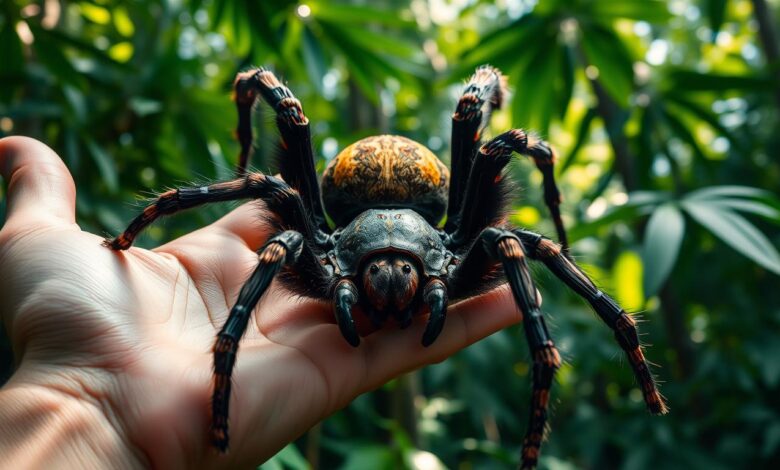
Get ready to be amazed by the Goliath Birdeater, the biggest spider in the world. Its legs can stretch up to 12 inches wide. This huge spider lives in the rainforests of northern South America.
It has a massive body and strong physique. This makes it the top spider in the kingdom.
The Goliath Birdeater can weigh up to 6 ounces. That’s like a small puppy or a small mammal. Females can live up to 25 years in captivity. Males live for 3 to 6 years.
These spiders hunt at night using their sharp senses. They catch insects, small mammals, frogs, and lizards.
Even though it looks scary, the Goliath Birdeater’s venom isn’t deadly to humans. It uses its venom to catch and hold its prey. Its fangs can be up to 1 inch long.
Unveiling the Goliath Birdeater: The World’s Largest Spider
The world’s largest spider, the Goliath Birdeater, is a true marvel of nature. It has a leg span over 12 inches and a body as big as a human hand. This massive arachnid is a sight to behold. It is scientifically known as Theraphosa blondi and is the biggest spider in the world.
Its massive size and imposing appearance make it a true heavyweight champion among spiders. Its size shows the incredible diversity and resilience of these ancient creatures.
| Characteristic | Measurement |
|---|---|
| Leg Span | Up to 12 inches |
| Body Size | As large as a human hand |
| Weight | Up to 6 ounces |
The largest spider on earth, the Goliath Birdeater, is a true marvel of nature. It captivates the hearts and minds of people worldwide. Its colossal size and impressive physique make it a true icon of the invertebrate world.
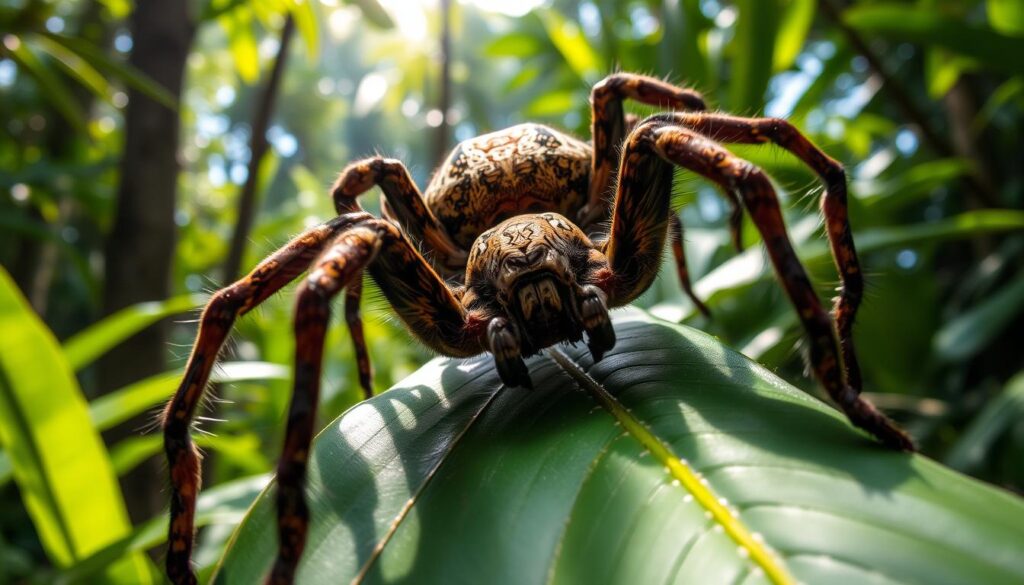
An Ancient Lineage: The Evolution of Giant Arachnids
The Goliath Birdeater’s huge size comes from an ancient lineage. This lineage has produced some of the largest arthropods on Earth. The Goliath Birdeater shows the amazing diversity and resilience of these creatures.
Tracing the Origins of Megafauna Invertebrates
Scientists are intrigued by the evolution of giant arachnids. They study fossils and genetics to tell their story. These spiders have traveled from ancient seas to today’s forests and grasslands.
Adaptations for Survival: Gigantism in the Arthropod World
The Goliath Birdeater’s size and strength come from adaptations. These adaptations have helped them survive and thrive for millennia. They have evolved unique ways to eat and protect themselves.
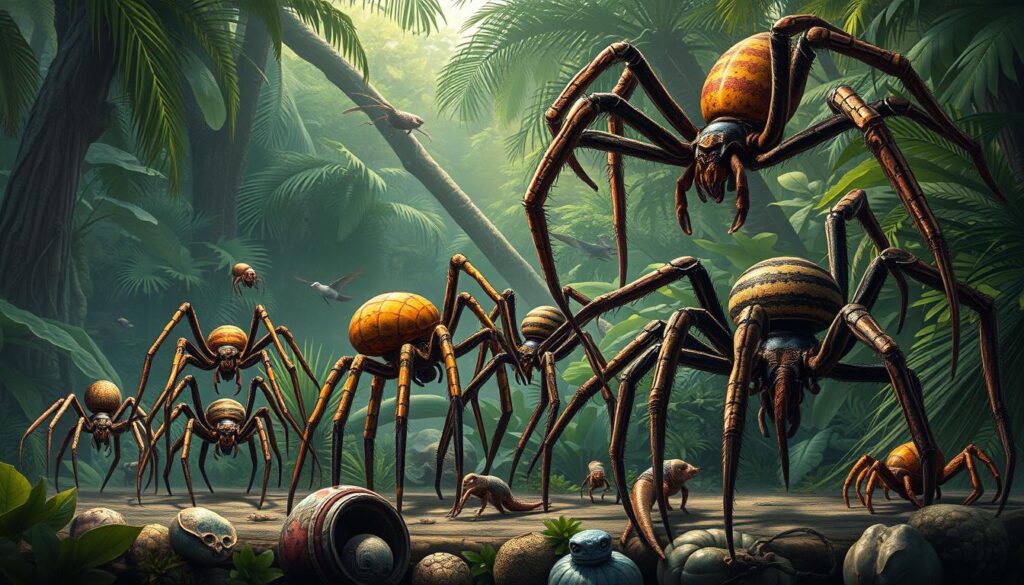
Exploring the Goliath Birdeater’s history shows us their incredible diversity. Their story is a testament to evolution’s power and life’s resilience.
Theraphosa Blondi: The Reigning King of Spiders
The Theraphosa blondi, or Goliath Birdeater, is the largest spider in the world. It is a true marvel of nature. Its massive size makes it stand out from other spiders.
Exploring the Goliath Birdeater’s Imposing Physique
The Goliath Birdeater has a leg span of up to 12 inches. Its body is as big as a human hand. It has a strong exoskeleton, powerful fangs, and many sensory organs.
This spider is the heaviest known, weighing up to six ounces (170 grams). Its arachnid physique shows the amazing diversity and adaptability of nature. It highlights the evolution of giant invertebrates.
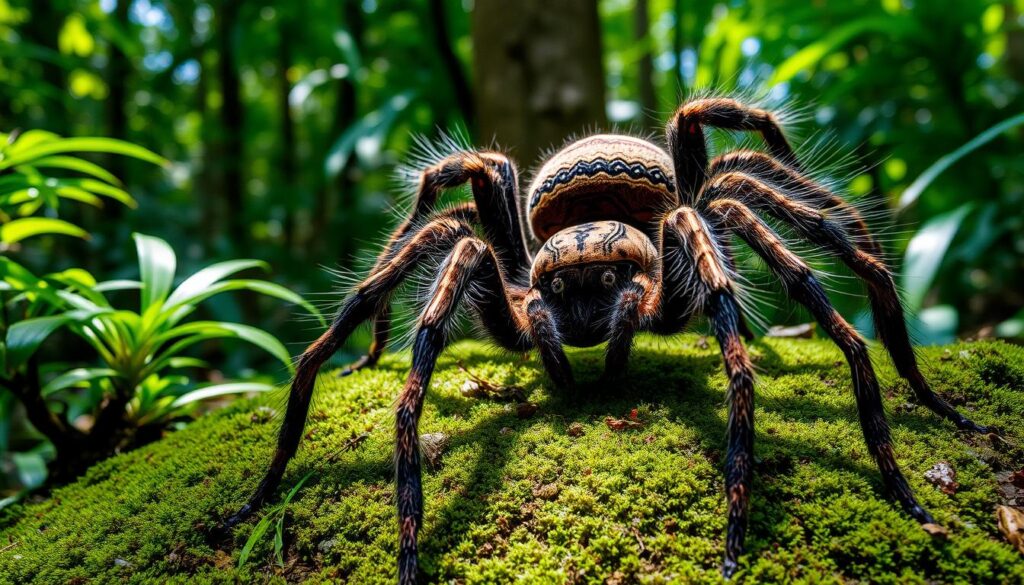
The reigning king of spiders is not just big. It’s also fast and venomous. It can move up to a yard per second. Its venom can cause severe pain and cramping.
Habitat and Distribution: Where These Monstrous Arachnids Dwell
The Goliath Birdeater, the world’s largest spider, lives in the rainforests of northern South America. It is mainly found in Venezuela, Brazil, and Guyana. These places have the right mix of humidity and heat for these spiders to thrive.
These spiders are huge and scary, making them a topic of both wonder and fear. They hide in burrows in the thick vegetation. There, they wait to catch their prey by surprise. Their presence shows how rich and varied the Amazon ecosystem is.
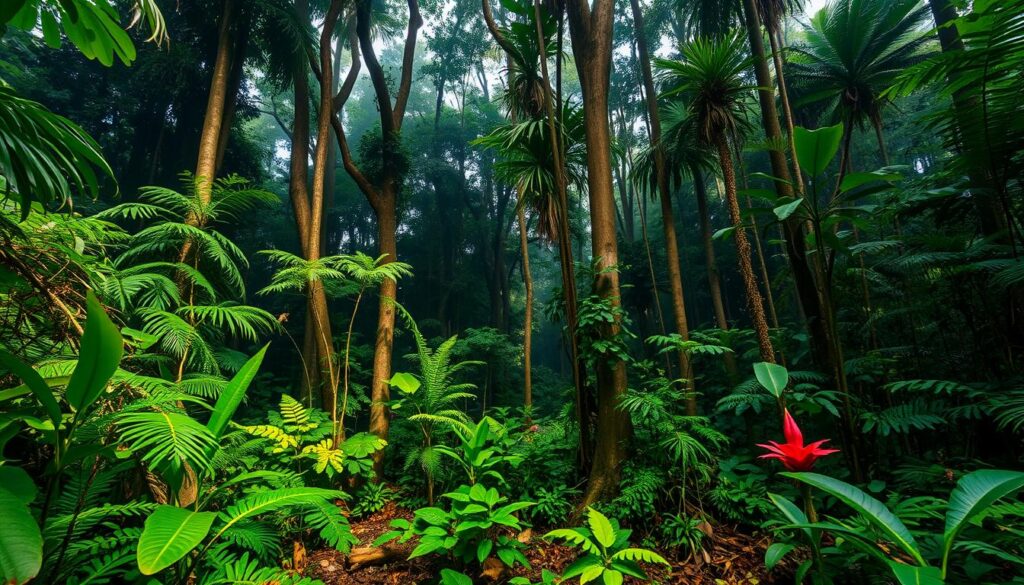
But the Goliath Birdeater isn’t the only big spider in South America. The area is full of giant spiders, each with its own special ways of living. Knowing where these spiders live helps us protect them and understand the natural world better.
Feeding Habits: How the World’s Biggest Spider Hunts
The Goliath Birdeater is the world’s largest spider. It has a unique way of hunting. With its huge size and strong fangs, it can catch small animals like rodents, frogs, and birds.
Decoding the Dietary Preferences of Theraphosa Blondi
Watching the Goliath Birdeater hunt is amazing. It uses speed, strength, and venom to catch its prey. After catching it, the spider eats the internal organs, leaving nothing behind.
The dietary preferences of Theraphosa blondi include many small animals. It loves rodents, frogs, and sometimes birds. Its venom quickly knocks out the prey, making it easy to eat.
| Prey Type | Frequency of Consumption |
|---|---|
| Rodents | Frequent |
| Frogs | Common |
| Small Birds | Occasional |
| Insects | Supplementary |
The Goliath Birdeater’s how the world’s biggest spider hunts shows its amazing abilities. It is a true marvel of nature.
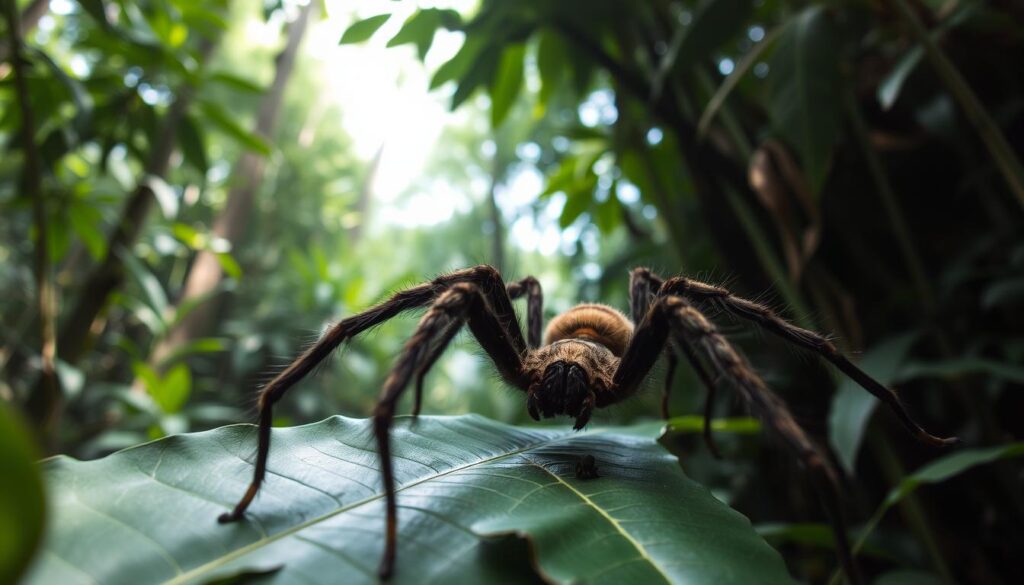
Defensive Mechanisms: Surviving in a Hostile Environment
The Goliath Birdeater, the world’s largest spider, has developed many ways to stay safe in the rainforest. It uses different strategies to protect itself from predators. These methods help it survive and even thrive in its challenging environment.
One key defense is its ability to release irritating hairs from its belly. These tiny hairs can make potential threats uncomfortable. This helps the spider keep a safe distance from danger.
The Goliath Birdeater also has strong fangs that can hurt a lot. Its size and strength make it a tough opponent. This means predators think twice before attacking it.
Its thick, strong shell is another important defense. This shell protects the spider from harm. It helps the Goliath Birdeater deal with the dangers of its rainforest home.
Thanks to these defenses, the Goliath Birdeater can live and grow in the rainforest. It has found a way to survive and even thrive. This makes it the largest spider in the world.
The Fascinating World of Tarantula Behavior
Explore the world of tarantulas, where these giant spiders show surprising complexity. Their courtship rituals and parental care are fascinating. These behaviors give us a peek into their lives.
Uncovering the Mysteries of Monstrous Arachnid Courtship
The Goliath Birdeater’s courtship dance is amazing. Males use bright colors and dance to attract females. Scientists have studied this ritual, revealing the social behaviors of these giant spiders.
Parental Care: How Goliath Birdeaters Nurture Their Young
Goliath Birdeaters are surprisingly caring parents. Females build silk sacs to protect their babies. When the spiderlings hatch, mothers defend them against predators. This care helps their young survive in a tough world.
By studying tarantulas, we learn more about these amazing creatures. Their courtship and parental care are inspiring. These behaviors show how tarantulas adapt and survive.
Captive Breeding: Preserving the World’s Largest Spider
The Goliath Birdeater, the world’s largest spider, faces a tough future in the wild. Threats like habitat loss and over-collection are big problems. To help, conservationists are using captive breeding programs.
These programs have been very successful. Breeders have kept and even grown Goliath Birdeater populations in safe places. This means future generations can still see the world’s largest spider.
Captive breeding not only increases the spider’s numbers. It also helps scientists learn more about them. By studying these spiders in a safe place, researchers can find better ways to protect them in the wild.
The captive breeding of goliath birdeaters is making progress. The goal is to save the world’s largest spider and other giant spiders. Together, we can keep this amazing creature alive for future generations.
Record-Breaking Arthropods: The World’s Largest Spider and Its Kin
The Goliath Birdeater is the world’s largest spider, but it’s not alone. Around the world, many giant spider species have caught the eye of scientists and nature lovers. These include the huge Huntsman spiders of Australia and the tall Tarantulas of Central and South America. They are the top of the invertebrate megafauna list.
These giant spider species show amazing adaptations that help them survive. The Huntsman spider moves fast, and the Tarantula has strong venom. These monstrous arachnids have become the top of their food chains.
Learning about record-breaking arthropods is fascinating. It also teaches us about the limits of how big animals can get. By studying these megafauna invertebrates, we learn about the diversity and strength of life on Earth.
The Goliath Birdeater, Huntsman spider, and others are the peak of arachnid evolution. By exploring these record-breaking arthropods, we gain a deeper understanding of our world. We see the incredible ways these giant spider species have adapted to thrive.
Cultural Significance: Myths and Legends Surrounding Giant Spiders
The Goliath Birdeater, the world’s largest spider, is both fascinating and feared. It lives in the rainforests of northern South America. Myths and legends tell of it as a monster that attacks humans. These stories show how people are both amazed and scared by these huge spiders.
In the Inca state religion, the Goliath Birdeater might have been linked to gods like Viracocha and Inti. Its huge size and scary look made it seem divine. People might have held rituals at special places to honor these spiders.
But the Goliath Birdeater’s legend isn’t just for the Inca. Similar stories exist in other Amazon communities. These tales show how giant spiders capture our imagination. They remind us of the awe-inspiring power of nature.
As we learn more about the Goliath Birdeater and other giant spiders, their cultural importance will grow. They continue to fascinate us, showing the deep impact of nature on our beliefs.
Ethical Considerations: Responsible Interactions with Megafauna Invertebrates
As people become more interested in giant spiders like the Goliath Birdeater, concerns about interacting with them ethically grow. It’s important to balance our curiosity with the need to protect these megafauna invertebrates. This balance ensures their well-being and helps in their conservation.
Experts say we should use sustainable methods. This includes responsible breeding programs and eco-tourism. These actions help us learn about these animals without harming their homes. By being mindful, we can respect and care for these ethical considerations for giant spiders and their habitats.
Balancing Conservation and Curiosity
When we interact with megafauna invertebrates like the Goliath Birdeater, we must think carefully. Here are some key points to consider:
- Keep the animal’s home as undisturbed as possible
- Make sure the spider is safe and healthy during interactions
- Support education that teaches us to appreciate without harming
- Back research that helps protect these species
By finding a balance, we can learn more about these amazing creatures. We also help ensure their survival for the future.
Sustainable Practices for the Future
Using sustainable methods is crucial for megafauna invertebrates like the Goliath Birdeater. These methods include:
- Keeping captive populations healthy and diverse
- Teaching the public about these species’ importance
- Helping conservation efforts with the money made
- Reducing the harm caused by human contact
By choosing these sustainable practices, we can enjoy learning about these creatures. At the same time, we protect them for generations to come.
World Largest Spider: Exploring the Goliath Birdeater’s Realm
Visiting the lush rainforests of northern South America is like stepping into the Goliath Birdeater’s world. These massive spiders live in a world full of danger and beauty. Seeing a Goliath Birdeater in its natural habitat is breathtaking. It shows us the power and grace of these spiders up close.
Tarantulas, the family of the Goliath Birdeater, come in all sizes. They can be as small as a palm or as big as a human hand. Found almost everywhere, they adapt to different environments, from rainforests to deserts. Their eight eyes help them see and hunt better.
Tarantulas hunt at night and are usually alone. They use patience and ambush to catch prey. A recent TikTok video showed tarantulas and frogs working together. This shows how tarantulas can help other animals, showing the complex nature of life.
Exploring the Goliath Birdeater’s world lets us see the largest spider on Earth. It’s a lesson in evolution and survival. By seeing their domain, we learn about the balance of nature and their important role in it.
Conservation Efforts: Protecting the World’s Monstrous Arachnids
The Goliath Birdeater, the world’s largest spider, faces many dangers. These include habitat loss, poaching, and climate change. To help, conservation groups and scientists are working hard. They aim to protect these giant spiders and their homes.
Creating safe places for giant spiders is a big part of the effort. This means setting aside areas where they can live without human harm. Also, breeding them in captivity helps keep their numbers up and protects them from extinction.
There’s also a push for eco-friendly tourism. This helps raise money and awareness for conservation efforts for giant spiders. It lets people see these amazing spiders in their natural setting. This can help people understand why it’s important to protect the world’s largest spiders.
Scientists are also studying these megafauna invertebrates more. They want to learn about their lives and how they adapt. This knowledge will help come up with better ways to keep them safe.
By working together, we can save the world’s largest spider and its family. This includes protecting their homes, breeding them in captivity, promoting eco-friendly tourism, and doing research. Together, we can make sure these incredible creatures continue to amaze and inspire us.
Future Research: Unraveling the Mysteries of Gigantism
Our interest in the Goliath Birdeater and other huge spiders is growing. Scientists are ready to explore the evolution and biology of these amazing creatures. They will use new imaging, genetic studies, and field work to learn more.
This research will help us understand how these spiders got so big. We’ll also learn about their survival skills and how they fit into their worlds.
Studying giant spiders could teach us a lot about life on Earth. By looking into arachnid gigantism, we might discover new things about diversity and resilience. This could reveal how these creatures evolved over time.
As we learn more about the Goliath Birdeater and others, we’ll make exciting discoveries. These findings will help us understand these natural wonders better. They will also encourage us to protect and preserve their habitats.
Encountering the Goliath Birdeater: A Bucket List Experience
Seeing the Goliath Birdeater, the world’s largest spider, is unforgettable. It’s a must-do for your bucket list. These huge spiders, with their massive size, can amaze anyone who sees them. You can see them in South America’s rainforests or in a controlled setting.
Imagine seeing a Goliath Birdeater come out of its burrow. It has a leg span of up to 12 inches and is as big as a mid-sized smartphone. These spiders, weighing almost six ounces, show the wonders of evolution. Seeing them defend themselves, like hissing and shedding hairs, is unforgettable.
Going on a guided tour in Guyana, a less-visited part of South America, might let you see the Goliath Birdeater. Over 80% of Guyana is untouched rainforest. It’s perfect for wildlife lovers and those who want to explore the jungle. Guyana has many activities, like birdwatching and trekking, making it great for seeing the world’s largest spider.
